Discovery and exploration of the Solar System

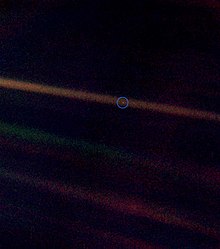
Discovery and exploration of the Solar System is observation, visitation, and increase in knowledge and understanding of Earth's "cosmic neighborhood".[1] This includes the Sun, Earth and the Moon, the major planets Mercury, Venus, Mars, Jupiter, Saturn, Uranus, and Neptune, their satellites, as well as smaller bodies including comets, asteroids, and dust.[1]
The Solar System — our Sun's system of planets, moons, and smaller debris — is humankind's cosmic backyard. Small by factors of millions compared to interstellar distances, the spaces between the planets are daunting, but technologically surmountable.
— NASA[1]
History
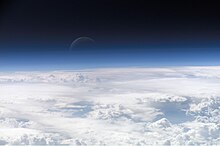

For many thousands of years, astronomers maintained a geocentric world view and did not recognize the existence of the Solar System. Most believed Earth was stationary at the center of the Universe and categorically different from the divine or ethereal objects that moved through the sky. Although the Greek philosopher Aristarchus of Samos had speculated on a heliocentric reordering of the cosmos, Nicolaus Copernicus in the 16th century developed a mathematically predictive heliocentric system. His 17th-century successors Galileo Galilei, Johannes Kepler, and Isaac Newton, developed a modern understanding of physics that led to the gradual acceptance of the idea that Earth moves around the Sun and that the planets are governed by the same physical laws that govern Earth. In more recent times, this led to the investigation of geological phenomena such as mountains and craters and seasonal meteorological phenomena such as clouds, dust storms, and ice caps on the other planets.
It is now know that the Solar System is one of many planetary systems in the galaxy.[1][2] The planetary system that contains Earth is named the "Solar" System because the local star, the Sun, is named Sol, after the Latin word for Sun, "solis".[2] Anything related to the Sun is called "solar"; for example, stellar wind from the Sun is called solar wind.
Antiquity and first observations
The first humans had limited understanding of the celestial bodies that could be seen in the sky. The Sun, however, was of immediate interest, as it generates the day-night cycle. Even more, the dawn and sunset always take part at roughly the same points of the horizon, which helped to develop the cardinal directions. The Moon was another body of immediate interest, because of its higher visual size. The Lunar phases allowed to measure time in longer periods than those of days, and predict the duration of seasons.[3]
One of the earliest recorded studies of astronomy is Ptolemy's Almagest. It proposed the geocentric model, with Earth at the center of the universe and the Sun, Moon, and planets in orbit around it. The stars would be fixed in a giant sphere, beyond Earth and the planets. The sun and the moon were in simple spheres, but the planets were thought to orbit around spheres that in turn orbited around Earth. It was a complex model, but it could predict the movements of the celestial bodies with a reliable accuracy, and remained in use until the 16th century.[4]
Telescopic observations
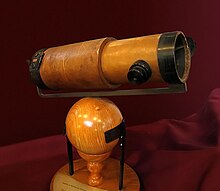
The first exploration of the Solar System was conducted by telescope, when astronomers first began to map those objects too faint to be seen with the naked eye.
Galileo was the first to discover physical details about the individual bodies of the Solar System. He discovered that the Moon was cratered, that the Sun was marked with sunspots, and that Jupiter had four satellites in orbit around it.[5] Christiaan Huygens followed on from Galileo's discoveries by discovering Saturn's moon Titan and the shape of the rings of Saturn.[6] Giovanni Domenico Cassini later discovered four more moons of Saturn and the Cassini division in Saturn's rings.[7]

Around 1677, Edmond Halley observed a transit of Mercury across the Sun, leading him to realise that observations of the solar parallax of a planet (more ideally using the transit of Venus) could be used to trigonometrically determine the distances between Earth, Venus, and the Sun.[8] In 1705, Halley realised that repeated sightings of a comet were recording the same object, returning regularly once every 75–76 years. This was the first evidence that anything other than the planets orbited the Sun,[9] though this had been theorized about comets in the 1st century by Seneca.[10] Around 1704, the term "Solar System" first appeared in English.[11]
In 1781, William Herschel was looking for binary stars in the constellation of Taurus when he observed what he thought was a new comet. Its orbit revealed that it was a new planet, Uranus, the first ever discovered telescopically.[12]
Giuseppe Piazzi discovered Ceres in 1801, a small world between Mars and Jupiter. It was considered another planet, but after subsequent discoveries of other small worlds in the same region, it and the others were eventually reclassified as asteroids.[13]
By 1846, discrepancies in the orbit of Uranus led many to suspect a large planet must be tugging at it from farther out. Urbain Le Verrier's calculations eventually led to the discovery of Neptune.[14] The excess perihelion precession of Mercury's orbit led Le Verrier to postulate the intra-Mercurian planet Vulcan in 1859, but that would turn out not to exist: the excess perihelion precession was finally explained by Einstein's general relativity.
Although it is debatable when the Solar System was truly "discovered", three 19th century observations determined its nature and place in the Universe beyond reasonable doubt. First, in 1838, Friedrich Bessel successfully measured a stellar parallax, an apparent shift in the position of a star created by Earth's motion around the Sun. This was not only the first direct, experimental proof of heliocentrism, but also revealed, for the first time, the vast distance between the Solar System and the stars. Then, in 1859, Robert Bunsen and Gustav Kirchhoff, using the newly invented spectroscope, examined the spectral signature of the Sun and discovered that it was composed of the same elements as existed on Earth, establishing for the first time a physical similarity between Earth and the other bodies visible from Earth.[15] Then, Father Angelo Secchi compared the spectral signature of the Sun with those of other stars, and found them virtually identical. The realisation that the Sun was a star led to the hypothesis that other stars could have systems of their own, though this was not to be proven for nearly 140 years.

Further apparent discrepancies in the orbits of the outer planets led Percival Lowell to conclude that yet another planet, "Planet X", must lie beyond Neptune. After his death, his Lowell Observatory conducted a search that ultimately led to Clyde Tombaugh's discovery of Pluto in 1930. Pluto was, however, found to be too small to have disrupted the orbits of the outer planets, and its discovery was therefore coincidental. Like Ceres, it was initially considered to be a planet, but after the discovery of many other similarly sized objects in its vicinity it was reclassified in 2006 as a dwarf planet by the IAU.[14]
In 1992, the first evidence of a planetary system other than our own was discovered, orbiting the pulsar PSR B1257+12. Three years later, 51 Pegasi b, the first extrasolar planet around a Sunlike star, was discovered. As of 2017, 2687 extrasolar planetary systems have been found.[16]
Also in 1992, astronomers David C. Jewitt of the University of Hawaii and Jane Luu of the Massachusetts Institute of Technology discovered 15760 Albion. This object proved to be the first of a new population, which became known as the Kuiper belt; an icy analogue to the asteroid belt of which such objects as Pluto and Charon were deemed a part.[17][18]
Mike Brown, Chad Trujillo and David Rabinowitz announced the discovery of Eris in 2005, a scattered disc object initially thought to be larger than Pluto, which would make it the largest object discovered in orbit around the Sun since Neptune.[19] New Horizons' fly-by of Pluto in July 2015 resulted in more-accurate measurements of Pluto, which is slightly larger, though less massive, than Eris.
Observations by spacecraft
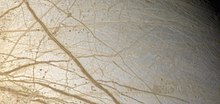

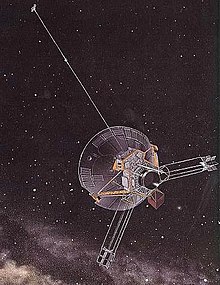
Since the start of the Space Age, a great deal of exploration has been performed by robotic spacecraft missions that have been organized and executed by various space agencies.
All planets in the Solar System have now been visited to varying degrees by spacecraft launched from Earth. Through these unmanned missions, humans have been able to get close-up photographs of all the planets and, in the case of landers, perform tests of the soils and atmospheres of some.
The first artificial object sent into space was the Soviet satellite Sputnik 1, launched in 1957, which successfully orbited Earth until 4 January the following year.[21] The American probe Explorer 6, launched in 1959, was the first satellite to image Earth from space.
Flybys
The first successful probe to fly by another Solar System body was Luna 1, which sped past the Moon in 1959. Originally meant to impact with the Moon, it instead missed its target and became the first artificial object to orbit the Sun. Mariner 2 was the first planetary flyby, passing Venus in 1962. The first successful flyby of Mars was made by Mariner 4 in 1965. Mariner 10 first passed Mercury in 1974.
The first probe to explore the outer planets was Pioneer 10, which flew by Jupiter in 1973. Pioneer 11 was the first to visit Saturn, in 1979. The Voyager probes performed a grand tour of the outer planets following their launch in 1977, with both probes passing Jupiter in 1979 and Saturn in 1980–1981. Voyager 2 then went on to make close approaches to Uranus in 1986 and Neptune in 1989. The two Voyager probes are now far beyond Neptune's orbit, and are on course to find and study the termination shock, heliosheath, and heliopause. According to NASA, both Voyager probes have encountered the termination shock at a distance of approximately 93 AU from the Sun.[22]
The first flyby of a comet occurred in 1985, when the International Cometary Explorer (ICE) passed by the comet Giacobini–Zinner,[23] whereas the first flybys of asteroids were conducted by the Galileo space probe, which imaged both 951 Gaspra (in 1991) and 243 Ida (in 1993) on its way to Jupiter.
Launched on January 19, 2006, the New Horizons probe is the first man-made spacecraft to explore the Kuiper belt. This unmanned mission flew by Pluto in July 2015. The mission was extended to observe a number of other Kuiper belt objects, including a close flyby of 486958 Arrokoth on New Year's Day, 2019.[24]
As of 2011, American scientists are concerned that exploration beyond the Asteroid Belt will hampered by a shortage of Plutonium-238.[needs update]
Orbiters, rovers and landers and flying probes
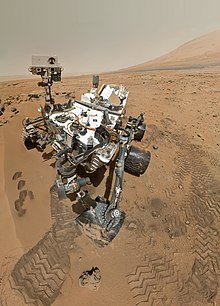
In 1966, the Moon became the first Solar System body beyond Earth to be orbited by an artificial satellite (Luna 10), followed by Mars in 1971 (Mariner 9), Venus in 1975 (Venera 9), Jupiter in 1995 (Galileo), the asteroid 433 Eros in 2000 (NEAR Shoemaker), Saturn in 2004 (Cassini–Huygens), and Mercury and Vesta in 2011 (MESSENGER and Dawn respectively). Dawn is orbiting the asteroid–dwarf planet Ceres as of 2015.
The first probe to land on another Solar System body was the Soviet Luna 2 probe, which impacted the Moon in 1959. Since then, increasingly distant planets have been reached, with probes landing on or impacting the surfaces of Venus in 1966 (Venera 3), Mars in 1971 (Mars 3, although a fully successful landing didn't occur until Viking 1 in 1976), the asteroid 433 Eros in 2001 (NEAR Shoemaker), and Saturn's moon Titan (Huygens) and the comet Tempel 1 (Deep Impact) in 2005. The Galileo orbiter also dropped a probe into Jupiter's atmosphere in 1995; because Jupiter has no physical surface, it was destroyed by increasing temperature and pressure as it descended.
To date, only two worlds in the Solar System, the Moon and Mars, have been visited by mobile rovers. The first robotic rover to visit another celestial body was the Soviet Lunokhod 1, which landed on the Moon in 1970. The first to visit another planet was Sojourner, which travelled 500 metres across the surface of Mars in 1997. The first flying probe on in solar system is Vega balloons, while first powered flight was undertook by Ingenuity. The only manned rover to visit another world was NASA's Lunar Roving Vehicle, which traveled with Apollos 15, 16 and 17 between 1971 and 1972.
Spacecraft exploration
Overview of some missions to the Solar System.
| # | Spacecraft | Launch year |
Mercury | Venus | Mars | Ceres | Jupiter | Saturn | Uranus | Neptune | Pluto | End year |
|---|---|---|---|---|---|---|---|---|---|---|---|---|
| 1 | Venera 3 | 1965 | Crash landing | 1966 | ||||||||
| 2 | Pioneer 10 | 1972 | Flyby | 2003 | ||||||||
| 3 | Pioneer 11 | 1973 | Flyby | Flyby | 1995 | |||||||
| 4 | Mariner 10 | 1973 | Flyby | Flyby | 1975 | |||||||
| 5 | Voyager 1 | 1977 | Flyby | Flyby | — | |||||||
| 6 | Voyager 2 | 1977 | Flyby | Flyby | Flyby | Flyby | — | |||||
| 7 | Galileo | 1989 | Flyby | Orbiter | 2003 | |||||||
| 8 | Ulysses | 1990 | Flyby | 2009 | ||||||||
| 9 | Cassini | 1997 | Flyby | Flyby | Orbiter | 2017 | ||||||
| 10 | Mars Odyssey | 2001 | Orbiter | — | ||||||||
| 11 | MER-A / B | 2003 | Rovers | 2010 / 2018 | ||||||||
| 12 | Mars Express | 2003 | Orbiter | — | ||||||||
| 13 | MESSENGER | 2004 | Orbiter | Flyby | 2015 | |||||||
| 14 | MRO | 2005 | Orbiter | — | ||||||||
| 15 | Venus Express | 2005 | Orbiter | 2014 | ||||||||
| 16 | New Horizons | 2006 | Flyby | Flyby | — | |||||||
| 17 | Dawn | 2007 | Orbiter | 2018 | ||||||||
| 18 | Juno | 2011 | Orbiter | — | ||||||||
| 19 | Curiosity (MSL) | 2011 | Rover | — | ||||||||
| 20 | Perseverance (Mars 2020) | 2020 | Rover | — | ||||||||
| 20 | Ingenuity (Mars 2020) | 2020 | Flying probe | — |
See also the categories for missions to comets, asteroids, the Moon, and the Sun.
Crewed exploration

Crewed exploration of the Solar System ended in 1972. The first human being to reach space (defined as an altitude of over 100 km) and to orbit Earth was Yuri Gagarin, a Soviet cosmonaut who was launched in Vostok 1 on April 12, 1961. The first human to walk on the surface of another Solar System body was Neil Armstrong, who stepped onto the Moon on July 21, 1969 during the Apollo 11 mission; five more Moon landings occurred through 1972. The United States' reusable Space Shuttle flew 135 missions between 1981 and 2011. Two of the five shuttles were destroyed in accidents.
The first orbital space station to host more than one crew was NASA's Skylab, which successfully held three crews from 1973 to 1974. True human settlement in space began with the Soviet space station Mir, which was continuously occupied for close to ten years, from 1989 to 1999. Its successor, the International Space Station, has maintained a continuous human presence in space since 2001. In 2004, U.S. President George W. Bush announced the Vision for Space Exploration, which called for a replacement for the aging Shuttle, a return to the Moon and, ultimately, a crewed mission to Mars.
Exploration by country
Legend:
☄ - orbit or flyby[25]
Ѫ - successful landing on an object
⚗ - sample return
⚘ - manned mission[26]
ↂ - permanent inhabited space station[27]
| ' | LEO | Moon | Mars | Mars moons | SSSBs | Venus | Mercury | Outer Solar System |
|---|---|---|---|---|---|---|---|---|
| ☄⚘ↂ | ☄Ѫ⚗⚘ | ☄Ѫ | ☄ | ☄Ѫ⚗ | ☄Ѫ | ☄ | ☄ | |
| ☄⚘ↂ | ☄Ѫ⚗ | ☄Ѫ | ☄ | ☄ | ☄Ѫ | |||
| ☄⚘ↂ | ||||||||
| ☄ | ||||||||
| ☄⚘ↂ | ☄Ѫ⚗ | ☄Ѫ | ☄ | |||||
| ☄ↂ | ☄ | ☄ | ☄ | ☄Ѫ | ☄ | ☄Ѫ | ||
| ☄ↂ | ☄ | ☄Ѫ⚗ | ☄ | |||||
| ☄ | ☄ | ☄ | ||||||
| ☄ | ||||||||
| ☄ | ☄ | |||||||
| ☄ | ||||||||
| ☄ | ||||||||
| ☄ | ||||||||
| Commercial | ☄⚘ | ☄ |
Notes:
- Only successful or partially successful missions are counted; instruments on a spacecraft made by another country are not counted as a separate mission
- Clicking on the symbol opens an article describing the first successful mission in that category
Exploration survey
Bodies imaged up close: Template:SolarSummaryLarge
Sample return
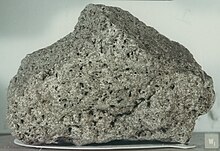
- Moon (Misc. missions including Apollo, Luna and Chang'e)
- Comet dust (Stardust)
- Solar wind (Genesis)
- Asteroid (Hayabusa)
See also: Meteorites and Cosmic dust
See also
References
- ^ a b c d Solar System Exploration
- ^ a b "Our Solar System". NASA. Retrieved 2021-08-04.
- ^ Masip, pp. 15-16
- ^ Masip, pp. 16-19
- ^ Eric W. Weisstein (2006). "Galileo Galilei (1564–1642)". Wolfram Research. Retrieved 2010-10-27.
- ^ "Discoverer of Titan: Christiaan Huygens". ESA Space Science. 2005. Retrieved 2010-10-27.
- ^ "Giovanni Domenico Cassini (June 8, 1625–September 14, 1712)". SEDS.org. Retrieved 2006-11-08.
- ^ Jeremiah Horrocks, William Crabtree, and the Lancashire observations of the transit of Venus of 1639, Allan Chapman 2004 Cambridge University Press doi:10.1017/S1743921305001225
- ^ "Comet Halley". University of Tennessee. Retrieved 2006-12-27.
- ^ Sagan, Carl & Druyan, Ann (1997). Comet. New York: Random House. pp. 26–27, 37–38. ISBN 978-0-3078-0105-0.
- ^ "Etymonline: Solar System". Retrieved 2008-01-24.
- ^ "Herschel, Sir William (1738–1822)". enotes.com. Archived from the original on 2006-05-09. Retrieved 2006-11-08.
- ^ "Discovery of Ceres: 2nd Centenary, January 1, 1801–January 1, 2001". astropa.unipa.it. 2000. Archived from the original on 2006-10-12. Retrieved 2006-10-12.
- ^ a b J. J. O'Connor & E. F. Robertson (1996). "Mathematical discovery of planets". St. Andrews University. Retrieved 2006-11-08.
- ^ "Spectroscopy and the Birth of Astrophysics". Center for History of Physics, a Division of the American Institute of Physics. Retrieved 2008-04-30.
- ^ "Extrasolar Planets Encyclopedia". Paris Observatory. Retrieved 2017-02-15.
- ^ Jane X. Luu & David C. Jewitt (2002). "KUIPER BELT OBJECTS: Relics from the Accretion Disk of the Sun". Annual Review of Astronomy and Astrophysics. 40: 63–101. Bibcode:2002ARA&A..40...63L. doi:10.1146/annurev.astro.40.060401.093818. Retrieved 2006-11-09.
- ^ Minor Planet Center. "List of Trans-Neptunian Objects". Archived from the original on 2010-10-27. Retrieved 2010-10-27.
- ^ "Eris (2003 UB313)". Solstation.com. 2006. Retrieved 2010-10-27.
- ^ Donald Savage; Michael Mewhinney (2003-02-25). "Farewell Pioneer 10". NASA. Archived from the original on 2012-03-17. Retrieved 2007-07-11.
- ^ "Sputnik 1". NASA. Retrieved 2009-07-30.
- ^ Randy Culp (2002). "Time Line of Space Exploration". Archived from the original on 2006-08-28. Retrieved 2006-07-01.
- ^ Comet Space Missions, accessed 2007-10-23.
- ^ "New Horizons NASA's Pluto-Kuiper Belt Mission". 2006. Retrieved 2006-07-01.
- ^ The LEO column only shows the country's launches on its own carrier rockets
- ^ The column only shows the country's launches on its own carrier rockets
- ^ only stations with at least one module built by the country in question are counted
- ^ The USSR was dissolved at 26 December 1991. Russia, Ukraine and some other post-soviet countries inherited parts of its technological base
- ^ The EU entries also include achievements of individual EU members
Bibliography
- Masip, Joel Gabas (2016). El sistema solar, un rincón particular de la Vía Láctea [The Solar System, a special place of the Milky Way] (in Spanish). Spain: RBA. ISBN 978-84-473-8562-1.

